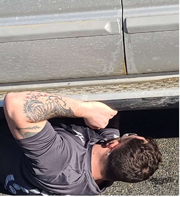By Samantha Ramcharran
There’s always an opportunity to improve someone’s daily life. I know many of my patients can relate when I mention my career and hobbies consume the bulk of my time. This usually leads to my curiosity about whether they are wearing the appropriate eyewear for both. I discovered how many ‘almost lost my vision’ stories came up. People suffer eye injuries from using improper eyewear or not using anything altogether. Scrapes and scratches on the cornea are extremely common (and painful by the way) but the good news is it is all preventable! Safety glasses over prescription glasses, protective goggles or face shields are protection for those precious eyes. There are a variety of safety glasses that can be worn over prescription glasses as well.
It’s all about asking the right questions to get your patient thinking, ‘why have I gone this long without considering safety glasses?!’ Asking open ended questions about their hobbies and careers invites them to comfortably describe a typical day or week. Risks for different kinds of work or hobbies warrant protection from specific hazards. For example, jobs such as construction, plumbing, carpentry, and auto work require eye protection from projectile impact. Welding requires special UV protection. Working in labs, especially industrial labs with toxic chemicals, require protection from splashes. Eyes need protection even for yardwork at home.
 |
Most hazardous jobs require safety glasses and employers will pay for them, specifying the type of eyewear necessary for the hazards of the work. Safety glasses must be worn while playing sports such as football, baseball, tennis, swimming, or basketball. Adults and children are advised to wear safety gear, especially when there’s a ball flying at them 60 miles per hour. Anyone with adventurous hobbies like scuba diving, shooting, cycling, even archery need to wear safety glasses.
Illustrate in plain terms the reasons safety glasses are crucial. The best way, and this works for me time after time, is being honest about the possible damage to their eyes. Vision loss is irreversible and time machines don’t exist to cure blindness. Something as small as accidentally scratching the cornea can lead to burning, pain, itching and swelling.
 |
Uncovering the risks to patients is a positive approach to help them realize what they are up against. Alleviate your patients’ concerns by showing them the protection available. Polycarbonate and Trivex are the most prescribed materials for children’s safety. Poly and Trivex are highly impact resistant and lightweight for prescriptions. Educate your patients in the design of safety glasses since they usually are a wrap, curved frame that covers the eyes completely versus regular eyewear that leaves gaps. The wrap design and shields protect from dust, sand, oil, blood, and debris in the air. Healthcare workers wearing safety glasses and face shields have lower contamination transmission with blood or fluid splashing on the lenses instead of into their eyes. Educating patients is a great part of being an optician and providing evidence for safety glasses instills trust with your patients.
If there aren’t restrictions for your safety wear, tints, colorful shields, or interchangeable pieces of foam can spruce up the eyewear. Instruct patients to replace damaged glasses immediately and update glasses every year or as often as needed. If used for work, eyewear must meet ANSI standards and fulfill task requirements. Remind patients that regular glasses don’t provide the same protection as safety eyewear and to address any concerns with their favorite optician. Muscles might be tough, but eyes are exposed, fragile organs that always must be treated with love and care!
Learn more about high-performance eyewear with our CE, Protecting Our Amazing Eyes, at
2020mag.com/ce.
















